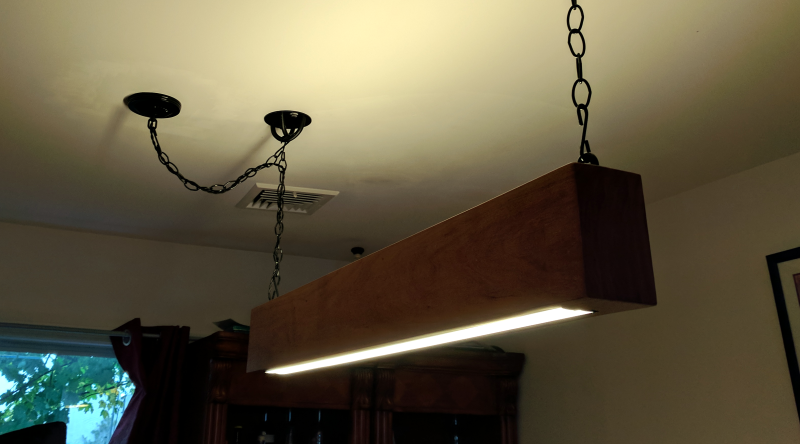Sometimes, you just can’t find something you want, and that’s when you break out the tools and get dirty with a bit of DIY. Reddit user [JaredBanyard] wanted a nice beam light for the dining room/gaming room. He ended up building one that shone both downward, on the table, and upward, adding some light to the room.
Warm white LED strip lighting was chosen, and two aluminum channels were glued together to hold them. After wiring the four LED strips together a diffuser was placed over them and then they were wired up and turned on to check the amount of light. With two strips per channel, even with the diffuser, there was plenty.
Each pair of channels were set into the main housing, which is made from Sirari hardwood. Two long outside side pieces make for a great looking final product, and the end pieces are sandwiched between the two outside pieces. After a bit of sanding and an application of matte polyacrylic, transformers were screwed inside and then the channels were placed on top. The circuitry was wired to a Z-Wave dimmer to control the lights remotely.
[JaredBanyard]’s put together a bill of materials and there are plenty of pictures. It’s a great, unique, light for the room, which includes a Duchess gaming table from boardgametables.com. For more lighting articles, check out this 2017 Hackaday Prize entry article on modular rail lighting, or this article about adding intelligence to your lighting solution.
[via Reddit]

















Not clear if separate power control of both up and down. Color temp should be adjustable. Hotter (blue) up is good with warmer down. Simple way would be this. Choice of color temp-time-of-day and reference to natural skylight (up) which is blue.
Why the color “should” be adjustable? All my light have a fixed color and it’s very good. Your “choice of color temp” add just sooooo more complexity and cost for a feature that he probably will never need (me neither, way too lazy)
It happens twice daily on earth, color change. The lighting on the ISS is also dimmed into the yellow for evening and blue-white during the day. This help orientate their bio clock to mission control time instead of messed up 90 minute changes. Computer displays can do this for late nite reading. The ultimate light source will go from a candlelight softness to 65K daylight in one continuous control range this is being done now.
Got into our newer delivery truck the other day. Blinding blue light coming out of every slit and wedge of the aftermarket stereo at night was an instant hazard. With Nike shoe styling on the control panel I couldn’t even find the power switch. A rag cover and I could drive. For decades the only blue indicator light was for your brights!
Daylight is not 6500 Kelvin, the skybox is. Daylight sunlight is ~5500 K. Smog will drop it lower though. With LEDs, th greatest efficacy will come from ~4000 K, if you pay attention to SPD plots and the photopic efficacy curve.
These are white leds and the color temp is set by the composition of the phosphor. So the color temp is fixed. It may vary a little bit with intensity.
They do make LED strips with alternating white and RGB leds, these might work to make an adjustable color temp source.
They also do LED modules with warm white, cool white, and amber instead of RGB. Don’t know if they make them in strips, but that would be very good for atmospheric lighting.
Yes, they certainly do make “WWA” LED strips, they’re readily available on Aliexpress etc.
The color is fixed for each LED, but if you simply mix warm LEDs with Cool LEDs you can simply change white temperature by mixing them…
It is very disturbing to humans to have two color temperatures of white simultaneously..
wow really love the wood light combo, the cables not so much, I would have taken smooth steel cable.
The chain screams 70’s light fixture.
You have to carve scallops in the edges of the wood and stain it a shade darker before you blame the 70s.
>>a shade darker
You misspelled “orange”
That’s what color the ceiling is.
I think early 80’s they removed the scalloping? So maybe up a few years?
You’re correct. Some ideas are timeless.
Using the channel as the heatsink is kinda lost when it’s so snugly fit there’s no free air circulation inside the box. It’s just as good as no heatsink, and the strips are going to cook pretty badly.
I have seen those strips glued to wood and other terrible heat conductors and the leds survived without a problem. Even without a lot of air exposure the aluminum will help pull the heat away.
The resistors make it so the strips dissipate 20-40% more power as heat than what is required. Drop 0 ohm ones instead to solve this issue.
I don’t think I would have put a diffuser on the top. The ceiling itself will act as a diffuser, and leaving the top open will give more light.
True, but a diffuse will reduce the obviousness of the weird, noticeably-bluer-than-everything-else bright spot on the ceiling.